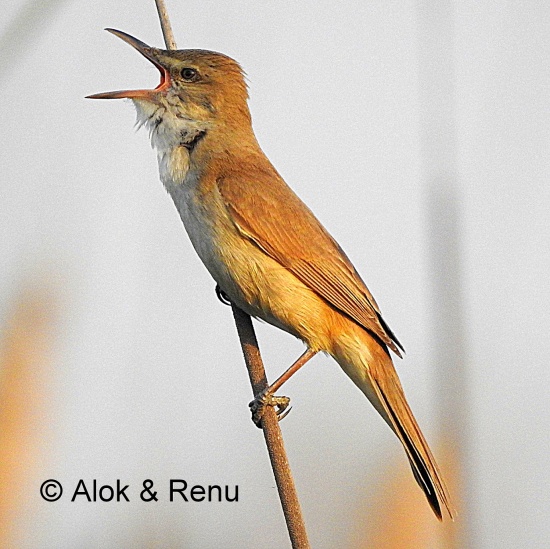
Photo by Alok Tewari
Basai Wetlands, Gurgaon, Haryana, India, 28 March 2016
- Acrocephalus stentoreus
Includes Indian Reed Warbler
Identification
18-20 cm (7-7¾ in)
- Brown back
- Whitish underparts
- Strong pointed bill
Sexes similar
Distribution
Africa, the Middle East and Asia
Northern Africa: Egypt
Eastern Africa: Sudan, Eritrea, Somalia
Middle East: Israel, Jordan, Arabian Peninsula, Oman, United Arab Emirates, Iran
Asia: China, Nepal, Pakistan, India, Andaman and Nicobar Islands, Sri Lanka, Bangladesh
Southeast Asia: Indochina, Myanmar, Vietnam, Thailand, Malaysia, Philippines, Borneo, Indonesia, Greater Sundas, Sumatra, Java, Sulawesi, Lesser Sundas, Bali, Timor, Moluccas
Taxonomy
Subspecies
There are 9 subspecies[1]:
- A. s. stentoreus:
- A. s. levantinus:
- Northern Israel
- A. s. brunnescens: (Indian Reed-Warbler)
- Breeds from the Red Sea (Eritrea and North West Somalia) to Kazakhstan and North India. Winters to India (see also Movements below for fuller information [Movements]
- A. s. amyae:
- A. s. meridionalis:
- A. s. harterti:
- Philippines (Luzon, Mindoro, Leyte, Bohol and Mindanao)
- A. s. celebensis:
- Southern Sulawesi
- A. s. siebersi:
- Western Java
- A. s. lentecaptus:
- South-eastern Borneo, Java and western Lesser Sundas (Lombok and Sumbawa)
Habitat
Large reed beds and bushes around lakes, ponds and along rivers.
Behaviour
Breeding
They construct a basket-like nest in the reeds. The clutch consists of 3-6 eggs.
Diet
Their diet consists almost entirely of insects, such as stoneflies, mayflies, dragonflies and damselflies.
Movements
Indian Reed Warbler (A.s. brunnescens) is the only race which has a migratory population, i.e all other races are sedentary. The ranges of the 2 populations of brunnescens are best listed separately as below:
Southern population (sedentary)
Red Sea coasts (Eritrea, North West Somalia and Saudi Arabia), the Persian Gulf (South Iran, Oman, UAE and eastern province of Saudi Arabia), coastal Arabian Sea in Pakistan (Sindh) and North India.
Northern population (migratory) Central Asia (North Iran and Turkmenistan north to South Kazakhstan, south to North Afghanistan and North Pakistan, including Uzbekistan and Tajikistan) winters to coastal South Iraq, South Iran and the Indian subcontinent.
Vocalisation
Recording by Alok Tewari
Dist. Gurgaon, India, March-2016
Calling from reed-bed in the wetlands now being drained.
References
- Clements, J. F., P. C. Rasmussen, T. S. Schulenberg, M. J. Iliff, T. A. Fredericks, J. A. Gerbracht, D. Lepage, A. Spencer, S. M. Billerman, B. L. Sullivan, and C. L. Wood. 2023. The eBird/Clements checklist of Birds of the World: v2023. Downloaded from https://www.birds.cornell.edu/clementschecklist/download/
- Avibase
- Handbook of the Birds of the World Alive (retrieved August 2016)
Recommended Citation
- BirdForum Opus contributors. (2025) Clamorous Reed Warbler. In: BirdForum, the forum for wild birds and birding. Retrieved 27 April 2025 from https://www.birdforum.net/opus/Clamorous_Reed_Warbler
External Links
GSearch checked for 2020 platform.1




